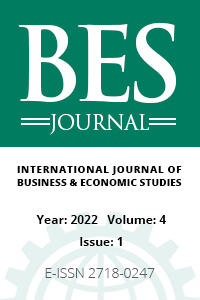The Effect of Cultural Intelligence on the Climate of Diversity
The climate of diversity is defined as “the common perceptions of employees about the way things are done”. The climate of diversity is at the centre of human resource management practices and policies. The climate of diversity is seen as an opportunity for the organization and turns into a useful tool when used brilliantly. The management of diversity, which sees the differences of individuals as wealth and aims to increase the differences, has an important potential in maintaining organizational development and equal opportunities for controlling organizational outputs. The main purpose of the current study is to determine the relationship between cultural intelligence and the climate of diversity. In the study, it was also examined whether cultural intelligence, the climate of diversity, the management of diversity and career perception vary significantly depending on the demographic characteristics of the employees. Anova, t-test and Pearson correlation method were used in empirical analyses. As a result of the analyses, a negative and statistically significant correlation was found between the cognitive dimension of the cultural intelligence scale and the scale of the climate of diversity, the work group factor and the organizational factors dimension. Moreover, it was determined that the individuals who are the citizens of the Turkish Republic have a higher level of cultural intelligence and a better perception of the climate of diversity than the ones who are not citizens.
Anahtar Kelimeler:
Cultural Intelligence, Diversity Climate, Diversity Management
The Effect of Cultural Intelligence on the Climate of Diversity
The climate of diversity is defined as “the common perceptions of employees about the way things are done”. The climate of diversity is at the centre of human resource management practices and policies. The climate of diversity is seen as an opportunity for the organization and turns into a useful tool when used brilliantly. The management of diversity, which sees the differences of individuals as wealth and aims to increase the differences, has an important potential in maintaining organizational development and equal opportunities for controlling organizational outputs. The main purpose of the current study is to determine the relationship between cultural intelligence and the climate of diversity. In the study, it was also examined whether cultural intelligence, the climate of diversity, the management of diversity and career perception vary significantly depending on the demographic characteristics of the employees. Anova, t-test and Pearson correlation method were used in empirical analyses. As a result of the analyses, a negative and statistically significant correlation was found between the cognitive dimension of the cultural intelligence scale and the scale of the climate of diversity, the work group factor and the organizational factors dimension. Moreover, it was determined that the individuals who are the citizens of the Turkish Republic have a higher level of cultural intelligence and a better perception of the climate of diversity than the ones who are not citizens.
Keywords:
Cultural Intelligence, Diversity Climate, Diversity Management,
___
- ADLER, Nancy J. (1991), “International Dimensions of Organizational Behavior”, Boston, MA: PWS-KENT.
- BEAN, Robert, Sammartino, A., O’Flynn, J., Lau, K., Nicholas, S. (2001), “Using Diversity Climate Surveys: A Toolkit for Diversity Management”, Programme for the Practice of Diversity Management by Department of Immigration and MulticulturalAffairs (DIMA) and Australian Centre for International Business (ACIB),
- BEGEÇ, Suat (2004). “Farklılıkların Yönetimi ve Genel Kurmay Başkanlığı Barış İçin Ortaklık Merkezinde Yapılan Bir Araştırma”, Marmara Üniversitesi Sosyal Bilimler Enstitüsü, İşletme Anabilim Dalı, İstanbul.
- BUDAK, Gülay ve Sürgevil, Olca (2008) “İşletmelerin Farklılıkların Yönetimi Anlayışına Yaklaşım Tarzlarının Saptanmasına Yönelik Bir Araştırma”, DEU Journal of GSSS, Sayı 10, Sayfa: 65-96.
- COX, Taylor H. (1991). The multicultural organization. Academy of Management Executive. 5, 34-47 Cox, Taylor H. ve Blake, Stacy, “Managing Cultural Diversity: Implications For Organizational Competiveness, The Academy Of Management Executive”, Vol. 5, No.3, August, 1991
- MARTINS, Luis L., Miliken, Frances J., Wiesenfeld, Batia M. &Salgado, Susan R (2003). “Racioethnicdivesity and group members’ experiences: the role of the racioethnic divesity of the organizational context”. Group&Organization Management. Vol. 28, No. 1, March, 75-106, Sage Publications.
- MEMDUHOĞLU, Hasan Basri (2007). “Yönetici ve öğretmen görüşlerine göre Türkiye’de kamu liselerinde farklılıkların yönetimi”. Doktora Tezi. Ankara Üniversitesi, Eğitim Bilimleri Enstitüsü İnternet Kaynakları
- MILLIKEN, Frances J., Martins, Luis L. (1996). “Searchinf for common threads: understanding the multiple effects of diversity in organzation groups”. Academy of Management Review. 21 (2), 402-433.
- MONTEI, M. S., Adams, G. A. ve Eggers, L. M. (1996). “Validity of scores on the Attitudes Toward Diversity Scale”. Educational and Psychological Measurement. 56:293-203.
- MOR Barak, Michal E. (2000). The inclusive workplace: “An ecosystems approach to diversity management.” National Association of Social Workers, Social Work. 45(4):339- 352.
- ROWNEY, Julie I. A. (2001). One step forward, or two stepsback Diversity management and gender in organizationalanalysis.(Erisim:10.09.2011) http://www.mngt.waikato.ac.nz/ejrot/cmsconference/2001/Papers/Gender/Miller.pdf,) Olgun, Onur, “Farklılık Yönetimi”, Erişim: http://www.cvtr.net/makale/haber.asp (Erişim,15.04.2020)
- SONNENSCHEIN, William (1997). The Diversity Toolkit: “How You Can Build and Benefit From a Diverse Workforce”. New York: Mc Graw Hill Companies.
- STOCKDALE, Margaret S., Cao, Feng (2004). Looking Back and Heading Forward: Major Themes of The Psychology and Management of Workplace Diversity. “The Psychology and Management of Workplace Diversity” (ss. 299-316) (Editorler: Stockdale, Margaret S., Crosby, Faye J.). USA: Blackwell Publishing.
- TSUI, Anne S., Egan, Terri D., ve O’Reilly III, Charles A. (1992). Being different: “Relational demography and organizational attachment.” Administrative Science Quarterly. 37:549-579.
- ÜNAL, L. Işıl (2003). “İlköğretim okullarında demokratik okul ortamının olusturulmasına kadın yöneticilerin katkısı.” Eğitim Bilim Toplum Dergisi. 1, 2/3 (baharyaz): Ankara. 112
- VONBERGEN C.V., Soper Barlow and Foster Teresa (2000). “Unıntended negatıve effects of dıversıty management”, Public Personel Management. Volume: 3, (2) Summer.
- WILLIAMS, Katherine & O’Reilly, Charles (1998). “Demography and diversity in organizations: A review of 40 years of research”. Research in Organizational Behavior. 20: 77-140.
- ISSN: 2718-0247
- Yayın Aralığı: Yılda 2 Sayı
- Yayıncı: Mesut DOĞAN
